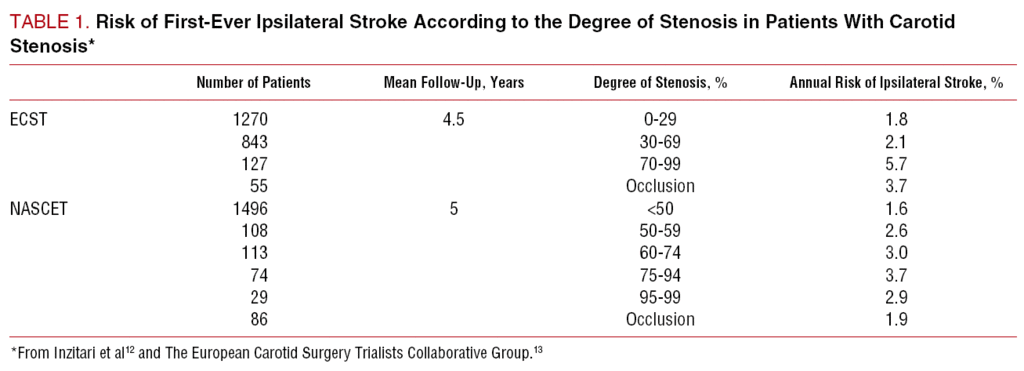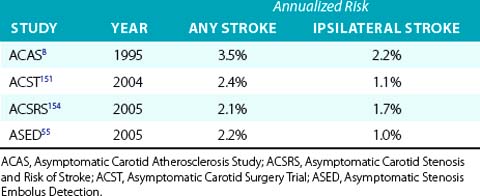Acas Carotid Study
Executive Committee for the Asymptomatic Carotid Atherosclerosis Study. 1995; 273(18):1421-8 (ISSN: 0098-7484) OBJECTIVE: To determine whether the addition of carotid endarterectomy to aggressive medical management can reduce the incidence of cerebral infarction in patients with asymptomatic carotid artery stenosis. Purpose: Proponents of carotid angioplasty and stenting suggest that “high risk” patients, defined as patients excluded from the North American Symptomatic Carotid Endarterectomy Trial (NASCET) and Asymptomatic Carotid Atherosclerosis Study (ACAS), may have a significantly higher risk of stroke with carotid endarterectomy (CEA). The list of abbreviations related to ACAS - Asymptomatic Carotid Atherosclerotic Study.
Carotid artery stenosis, also known asextracranial carotid artery stenosis, is usually caused by an atherosclerotic process and is one of the major causes of stroke and transient ischemic attack (TIA).
This article refers to stenosis involving the carotid bulb and the proximal segment of internal carotid artery (ICA), as both are the most common sites of symptomatic and clinically relevant stenosis.
Epidemiology
Carotid artery sclerosis is usually seen in the elderly and more commonly in males. In asymptomatic patients over the age of 80, approximately 3% of men and 1% of women will have severe stenosis 9.
Atherosclerotic carotid arterial disease accounts for ~15% of all ischemic strokes and TIAs 6,7. The annual incidence of extracranial carotid artery stenosis as a cause of stroke accounts for ~13 per 100,000 population in the USA 8.
Clinical presentation
Carotid artery stenosis can result in wide-ranging stroke syndromes or TIA symptoms 7.
Pathology
The plaques formed in the carotid vessels can be divided into four types:
- type I: predominantly hemorrhage, lipid, cholesterol, and proteinaceous material
- type II: dense fibrous connective tissue with >50% volume of hemorrhage, lipid, cholesterol, and proteinaceous material
- type III: dense fibrous connective tissue with <50% volume of hemorrhage, lipid, cholesterol, and proteinaceous material
- type IV: dense fibrous connective tissue
They can be termed as:
- homogenous (type III and IV)
- heterogenous (type I and II)

Radiographic features
Conventional angiography has been considered the standard method for evaluating carotid stenosis, moreover, the trials published in the 1990s (NASCET, ECST, and ACAS) were based on this method. However, the introduction and development of ultrasound Doppler, CT angiography (CTA), and MRI angiography (MRA) have been replacing angiography for diagnostic purposes, essentially reserving it for endovascular treatment.
Ultrasound
On grayscale, characterization of plaques can be performed:
Acas Carotid Study
- type I: predominantly hypoechoic with thin echogenic rim
- type II: echogenic plaque with >50% hypoechoic areas
- type III: echogenic plaque with <50% hypoechoic areas
- type IV: uniformly echogenic plaque
They can be termed as:
- homogenous (type III and IV)
- heterogenous (type I and II)
Doppler ultrasound has become the first choice for carotid stenosis screening, permitting the evaluation of both the macroscopic appearance of plaques as well as flow characteristics 5. Hemodynamically significant carotid stenosis is usually referred to a further CTA or MRA study.
Angiography (DSA)
The North American Symptomatic Carotid Endarterectomy Trial (NASCET) demonstrated a conclusive benefit for carotid endarterectomy in patients with symptomatic 70-99% ICA stenosis 2.
NASCET was established by angiographic calculation of ICA stenosis percentage using the following formula:
- % ICA stenosis = (1 - [narrowest ICA diameter/diameter normal distal cervical ICA]) x 100
The European Carotid Surgery Trial (ECST) also demonstrated benefits for carotid endarterectomy in patients with symptomatic higher than 80% ICA stenosis 3.
ECST was established by angiographic calculation of ICA stenosis percentage using the following formula:
- % ICA stenosis = (1 - [diameter of the most stenotic part/estimated original diameter at the site of the stenosis]) x 100
Treatment and prognosis
NASCET and ECST trials proved the benefits of performing endarterectomy in those patients with symptomatic high-grade stenosis. In 1995 the Asymptomatic Carotid Atherosclerosis Study (ACAS) demonstrated that patients with asymptomatic carotid artery stenosis of 60% or greater reduction in diameter benefited from endarterectomy, having a reduced 5-year risk of ipsilateral stroke 4.
Procedures used to treat carotid stenosis include carotid endarterectomy and carotid arterial stenting.
Differential diagnosis
- 1. Saba L, Mallarini G. A comparison between NASCET and ECST methods in the study of carotids: evaluation using Multi-Detector-Row CT angiography. Eur J Radiol. 2010;76 (1): 42-7. doi:10.1016/j.ejrad.2009.04.064 - Pubmed citation
- 2. Beneficial effect of carotid endarterectomy in symptomatic patients with high-grade carotid stenosis. N. Engl. J. Med. 1991;325 (7): 445-53. doi:10.1056/NEJM199108153250701 - Pubmed citation
- 3. Randomised trial of endarterectomy for recently symptomatic carotid stenosis: final results of the MRC European Carotid Surgery Trial (ECST). Lancet. 1998;351 (9113): 1379-87. Pubmed citation
- 4. Endarterectomy for asymptomatic carotid artery stenosis. Executive Committee for the Asymptomatic Carotid Atherosclerosis Study. JAMA. 1995;273 (18): 1421-8. Pubmed citation
- 5. Grant EG, Benson CB, Moneta GL et-al. Carotid artery stenosis: gray-scale and Doppler US diagnosis-Society of Radiologists in Ultrasound Consensus Conference. Radiology. 2003;229 (2): 340-6. doi:10.1148/radiol.2292030516 - Pubmed citation
- 6. Rajamani K, Chaturvedi S. Stroke prevention-surgical and interventional approaches to carotid stenosis. Neurotherapeutics. 2011;8 (3): 503-14. doi:10.1007/s13311-011-0052-2 - Free text at pubmed - Pubmed citation
- 7. Lovrencic-Huzjan A, Rundek T, Katsnelson M. Recommendations for management of patients with carotid stenosis. Stroke Res Treat. 2012;2012: 175869. doi:10.1155/2012/175869 - Free text at pubmed - Pubmed citation
- 8. Flaherty ML, Kissela B, Khoury JC et-al. Carotid artery stenosis as a cause of stroke. Neuroepidemiology. 2013;40 (1): 36-41. Free text at pubmed - Pubmed citation
- 9. Marjolein de Weerd, Jacoba P. Greving, Bo Hedblad, Matthias W. Lorenz, Ellisiv B. Mathiesen, Daniel H. O'Leary, Maria Rosvall, Matthias Sitzer, Erik Buskens, Michiel L. Bots. Prevalence of Asymptomatic Carotid Artery Stenosis in the General Population. (2010) Stroke. 41 (6): 1294-7. doi:10.1161/STROKEAHA.110.581058 - Pubmed
Promoted articles (advertising)


Carotid artery stenosis, also known asextracranial carotid artery stenosis, is usually caused by an atherosclerotic process and is one of the major causes of stroke and transient ischemic attack (TIA).
This article refers to stenosis involving the carotid bulb and the proximal segment of internal carotid artery (ICA), as both are the most common sites of symptomatic and clinically relevant stenosis.
Epidemiology
Carotid artery sclerosis is usually seen in the elderly and more commonly in males. In asymptomatic patients over the age of 80, approximately 3% of men and 1% of women will have severe stenosis 9.
Atherosclerotic carotid arterial disease accounts for ~15% of all ischemic strokes and TIAs 6,7. The annual incidence of extracranial carotid artery stenosis as a cause of stroke accounts for ~13 per 100,000 population in the USA 8.

Clinical presentation
Carotid artery stenosis can result in wide-ranging stroke syndromes or TIA symptoms 7.
Pathology
The plaques formed in the carotid vessels can be divided into four types:
- type I: predominantly hemorrhage, lipid, cholesterol, and proteinaceous material
- type II: dense fibrous connective tissue with >50% volume of hemorrhage, lipid, cholesterol, and proteinaceous material
- type III: dense fibrous connective tissue with <50% volume of hemorrhage, lipid, cholesterol, and proteinaceous material
- type IV: dense fibrous connective tissue
They can be termed as:
- homogenous (type III and IV)
- heterogenous (type I and II)
Radiographic features
Conventional angiography has been considered the standard method for evaluating carotid stenosis, moreover, the trials published in the 1990s (NASCET, ECST, and ACAS) were based on this method. However, the introduction and development of ultrasound Doppler, CT angiography (CTA), and MRI angiography (MRA) have been replacing angiography for diagnostic purposes, essentially reserving it for endovascular treatment.
Ultrasound
On grayscale, characterization of plaques can be performed:
- type I: predominantly hypoechoic with thin echogenic rim
- type II: echogenic plaque with >50% hypoechoic areas
- type III: echogenic plaque with <50% hypoechoic areas
- type IV: uniformly echogenic plaque
They can be termed as:
- homogenous (type III and IV)
- heterogenous (type I and II)
Doppler ultrasound has become the first choice for carotid stenosis screening, permitting the evaluation of both the macroscopic appearance of plaques as well as flow characteristics 5. Hemodynamically significant carotid stenosis is usually referred to a further CTA or MRA study.
Angiography (DSA)
The North American Symptomatic Carotid Endarterectomy Trial (NASCET) demonstrated a conclusive benefit for carotid endarterectomy in patients with symptomatic 70-99% ICA stenosis 2.
NASCET was established by angiographic calculation of ICA stenosis percentage using the following formula:
- % ICA stenosis = (1 - [narrowest ICA diameter/diameter normal distal cervical ICA]) x 100
The European Carotid Surgery Trial (ECST) also demonstrated benefits for carotid endarterectomy in patients with symptomatic higher than 80% ICA stenosis 3.
ECST was established by angiographic calculation of ICA stenosis percentage using the following formula:
- % ICA stenosis = (1 - [diameter of the most stenotic part/estimated original diameter at the site of the stenosis]) x 100
Treatment and prognosis
NASCET and ECST trials proved the benefits of performing endarterectomy in those patients with symptomatic high-grade stenosis. In 1995 the Asymptomatic Carotid Atherosclerosis Study (ACAS) demonstrated that patients with asymptomatic carotid artery stenosis of 60% or greater reduction in diameter benefited from endarterectomy, having a reduced 5-year risk of ipsilateral stroke 4.
Procedures used to treat carotid stenosis include carotid endarterectomy and carotid arterial stenting.
Differential diagnosis
- 1. Saba L, Mallarini G. A comparison between NASCET and ECST methods in the study of carotids: evaluation using Multi-Detector-Row CT angiography. Eur J Radiol. 2010;76 (1): 42-7. doi:10.1016/j.ejrad.2009.04.064 - Pubmed citation
- 2. Beneficial effect of carotid endarterectomy in symptomatic patients with high-grade carotid stenosis. N. Engl. J. Med. 1991;325 (7): 445-53. doi:10.1056/NEJM199108153250701 - Pubmed citation
- 3. Randomised trial of endarterectomy for recently symptomatic carotid stenosis: final results of the MRC European Carotid Surgery Trial (ECST). Lancet. 1998;351 (9113): 1379-87. Pubmed citation
- 4. Endarterectomy for asymptomatic carotid artery stenosis. Executive Committee for the Asymptomatic Carotid Atherosclerosis Study. JAMA. 1995;273 (18): 1421-8. Pubmed citation
- 5. Grant EG, Benson CB, Moneta GL et-al. Carotid artery stenosis: gray-scale and Doppler US diagnosis-Society of Radiologists in Ultrasound Consensus Conference. Radiology. 2003;229 (2): 340-6. doi:10.1148/radiol.2292030516 - Pubmed citation
- 6. Rajamani K, Chaturvedi S. Stroke prevention-surgical and interventional approaches to carotid stenosis. Neurotherapeutics. 2011;8 (3): 503-14. doi:10.1007/s13311-011-0052-2 - Free text at pubmed - Pubmed citation
- 7. Lovrencic-Huzjan A, Rundek T, Katsnelson M. Recommendations for management of patients with carotid stenosis. Stroke Res Treat. 2012;2012: 175869. doi:10.1155/2012/175869 - Free text at pubmed - Pubmed citation
- 8. Flaherty ML, Kissela B, Khoury JC et-al. Carotid artery stenosis as a cause of stroke. Neuroepidemiology. 2013;40 (1): 36-41. Free text at pubmed - Pubmed citation
- 9. Marjolein de Weerd, Jacoba P. Greving, Bo Hedblad, Matthias W. Lorenz, Ellisiv B. Mathiesen, Daniel H. O'Leary, Maria Rosvall, Matthias Sitzer, Erik Buskens, Michiel L. Bots. Prevalence of Asymptomatic Carotid Artery Stenosis in the General Population. (2010) Stroke. 41 (6): 1294-7. doi:10.1161/STROKEAHA.110.581058 - Pubmed